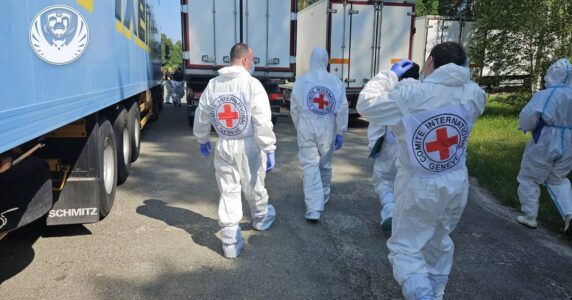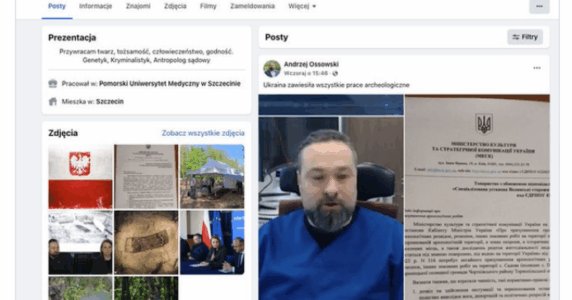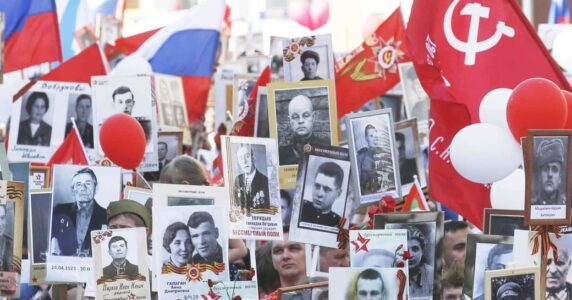Navigation and useful materials
May 8 is the Day of Remembrance and Victory over Nazism in World War II. Unfortunately, for more than 10 years in a row, Ukraine has been celebrating this date in wartime, and for the fourth time during a full-scale war with Russia, which is the largest armed conflict in Europe since 1945. The scale and intensity of the aggressor’s information operations are also unprecedented, and one of the tools in the hands of the Russian special services is speculation on the memory of World War II. This is the topic of a new study by the Center for Strategic Communications and Information Security “The Main Myth of Russian Propaganda. An Analysis of the Narrative of “Ukrainian Fascism”. The study analyzes the narrative system of Russian information manipulation and interference (FIMI), which is related to the memory of World War II and is used in the war against Ukraine.

The key element in the FIMI structure is a narrative, which is a story in the form of a generalized plot story that provides the target audience with an interpretation of certain phenomena and trends that, by its kinetic consequences (change in the target audience’s behavior), meets the military and political interests of the state subject to influence. The main place in the system of Russian propaganda about Ukraine is occupied by the narrative of “Ukrainian fascism”, which Moscow began to promote in the mid-2000s. The content of this narrative can be summarized in the following formula: “The war against Ukraine is a continuation of the holy war against fascism that Russia started in 1941”. Further analysis has revealed five main sub-narratives (i.e., variations of the main narrative) used in the course of information and psychological operations against Ukraine.
Directions of information attacks
So, we are talking about the following sub-narratives: “Ukraine is a fascist state,” “Ukraine is ruled by fascists”, “Nazi Ukraine is a threat to Russia,” “The Ukrainian army are modern Nazis”, “Russia is liberating the people of Ukraine from fascism”. In this presentation, all of this sounds like a set of tautological statements on the air of the program “Evening with Vladimir Solovyov” on Russia 1 TV channel. This impression is quite symptomatic. The words “(neo)Nazism”, “(neo)fascism”, “(aggressive) nationalism”, etc. are used by Russian propaganda without any connection to their historical or political meaning. They are simply a series of synonyms used to create an image of the enemy and dehumanize the victim. However, despite the confusing thesaurus, each of these sub-narratives has a very specific functional purpose that meets certain military and political goals of the Kremlin.

For example, the sub-narrative that Ukraine is a “fascist state” is aimed at denying Ukraine’s right to independence and sovereignty. If fascism is a man-hating ideology condemned by the world, attempts to revive it in the twenty-first century must be severely suppressed. And if this is allegedly done at the state level, such a state should suffer the fate of the Third Reich. In fact, in terms of its content and functional purpose, this sub-narrative duplicates another narrative: that Ukraine emerged as a result of a historical accident (created by Lenin, etc.), that Ukrainian identity is artificial (created by the Austrian General Staff, etc.). Both narratives represent two different “lines of accusation”: in one case, the encroachment on Ukraine’s sovereignty is justified by the claim that the Ukrainian state is allegedly “artificial,” in the other – that it is “fascist”.

The sub-narrative that Ukraine is allegedly ruled by “fascists” has a similar function. Russian propaganda began generating such false accusations in the mid-2000s, when it targeted the national-democratic President Viktor Yushchenko. Subsequently, the same fate befell the acting President of Ukraine Oleksandr Turchynov, and then Petro Poroshenko. The intensity of information attacks against Volodymyr Zelenskyy reached its peak after the start of the full-scale invasion. According to ongoing monitoring, the degree of absurdity is constantly increasing. For example, fakes are being spread about Zelenskyy allegedly buying a limousine and even Hitler’s entire residence, Goebbels’ villa, etc. The purpose of these fakes is obvious: to undermine the legitimacy of Ukraine’s top military and political leadership in the eyes of Ukrainians and the international community, and thus deprive Ukraine of governability and international support.
Russian propaganda is making special efforts to spread the sub-narrative that “Nazi Ukraine” was allegedly preparing to attack Russia. In fact, it is a matter of shifting the responsibility for the outbreak of war to Ukraine. This propaganda technique has been used since 2014. At that time, Moscow presented the hybrid invasion as a “civil war in Ukraine” that was allegedly taking place between “fascist radicals” and residents of the southern and eastern regions who were engaged in an “anti-fascist struggle.” In subsequent years, after the active phase of the Anti-Terrorist Operation in eastern Ukraine ended, the focus shifted to “Ukraine’s crimes against Donbas.” This strategy was aimed at constructing a casus belli for the start of a full-scale invasion of Ukraine. Thus, a criminal unprovoked attack on a sovereign state was positioned as an act of self-defense by Russia and the “Russian world”.

Attempts to discredit the Ukrainian Defense Forces are being made by promoting the sub-narrative that the Ukrainian army is like “modern Nazis”. For this purpose, Russia uses not only purely informational noise, such as the fake about the “crucified boy”, but also a number of kinetic means. For example, back in March 2022, one of the main propaganda mythologies was the accusation of Azov fighters of allegedly “destroying Mariupol”. In August 2022, the Russian Supreme Court declared Azov a “nationalist terrorist organization”. And already in August 2022, the Russian Federation was preparing to organize a propaganda campaign – a “tribunal” for “Ukrainian war criminals”, including “Nazis from Azov”, in Mariupol. Under pressure from the international community, the Kremlin abandoned this dirty provocation, but Ukrainian prisoners of war are regularly tried and given appropriate media coverage.

As for the sub-narrative that Russia is allegedly “liberating the people of Ukraine from fascism”, it is one of the main means of imposing occupation, ideological indoctrination, and forcibly changing the identity of local residents. The origins of this sub-narrative date back to 2014. At that time, the insignia of the Russian military and collaborators was the St. George’s ribbon, one of the symbols of the modern Russian “Victory Cult”. After the establishment of the occupation regime in the TOT of Ukraine, “anti-fascist” rhetoric, full of allusions to the events of World War II, became characteristic of the occupation administrations in Donetsk and Luhansk regions, as well as in Crimea. Residents of the TOT were imposed the identity of “victims of Ukrainian fascism” (allegedly “protected” by Russia), and at the same time – of the advanced detachment of the “anti-fascist resistance”. The latter was used to increase the militarization of TOT residents, including children and youth.

Counteraction strategy
The study of the narrative structure of Russian propaganda has an obvious applied aspect. Dissemination of true knowledge about World War II among vulnerable audiences is undoubtedly necessary. However, the intensity and scale of Russia’s information attacks do not allow us to limit ourselves to the means of science and education, because the ultimate goal of FIMI is not to misinform audiences as such, but to achieve the military and political goals of the aggressor state. It is important to remember that by their very nature, FIMI are operations led by intelligence services and implemented using a wide range of purely propaganda and more sophisticated and high-tech (and therefore much more dangerous) means of influencing public opinion.
That is why countering FIMI requires consolidated efforts of the state (including security services) and civil society, as well as deeper international cooperation. However, without an understanding of the narrative structure of FIMI, counteraction will be of limited effectiveness. In this context, an accurate narrative analysis is not an empty scholastic exercise, but a prerequisite for the correct mapping of information threats. And this is the starting point for building defense strategies on both a national and international scale.
Maksym Vikhrov, senior analyst at the Centre for Strategic Communication and Information Security, theukrainianreview.info
If you have found a spelling error, please, notify us by selecting that text and pressing Ctrl+Enter.


